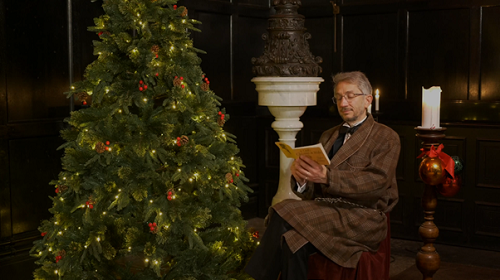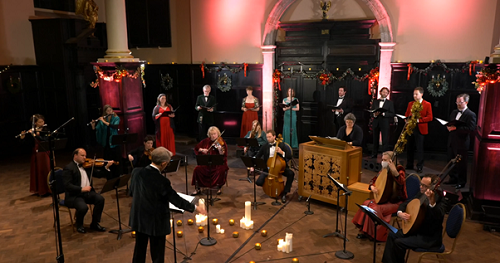Long, long ago,
Oh! so long ago
Christ was born in Bethlehem
To heal the world’s woe.
On Christmas Eve in 1940, while he was a prisoner of war at Laufen Castle in Bavaria, John Buxton (1912-89) wrote a poem, ‘Long, long ago’, that was published in a small collection, Such Liberty, in 1944. Buxton’s poem muses on Christ’s birth and our Saviour’s mission; it caught the eye of Herbert Howells whose ‘carol-anthem’ setting of Buxton’s text was composed in 1950 for the Lady Margaret Singers of Cambridge.
80 years to the day after Buxton penned his poem, Howells’ setting opened I Fagiolini’s Messe de Minuit Christmas Eve broadcast, from the VOCES8 Centre in the City of London. This Live from London concert was designed to replicate, in a flexible and imaginative way, the Midnight Mass service that would be denied so many this year, and to reflect the Ordinary (Kyrie, Gloria, Credo, Sanctus, Agnes Dei) and Proper (Introit, Gradual, etc.) parts of the Mass, and the spoken readings and prayers. So, Charpentier’s Messe de Minuit was interwoven with four anthems by Howells and spoken readings from Dylan Thomas’s A Child’s Christmas in Wales.
Howell’s ‘Long, long ago’ was a powerful Introit, sweeping the listener up in its stirring unison statement of the refrain and driving towards the jubilant arrival of the Shepherds at the stable – “Knew him for their King” shone vibrantly with their elation – and the more cerebral and grave gifting of gold, myrrh and frankincense by the three wise men. The final refrain was intense and contemplative, but before that I Fagiolini’s director Robert Hollingworth wove his singers’ voices into freely changing textures and pointed the piquant harmonies decisively and dramatically.
Marc-Antoine Charpentier’s (1643-1704) Messe minuit de Noël H.9 was composed in the 1690s while Charpentier worked at the Jesuit church of St. Louis in Paris. It is a rare example of a Baroque parody Mass, based on eleven popular French monophonic songs associated with Christmas – which are themselves derived from secular songs linked to Renaissance courtly dances – which are placed alongside and integrated with newly composed material.

But, before the Ordinary Mass began, Hollingworth donned a homely dressing-gown and settled into an armchair beside the St Anne and St Agnes Christmas tree, decorated with red-berries and gold lights, to deliver a splendid ‘Welsh-Dickens’ turn and read us the opening part of Dylan Thomas’s nostalgic tale of Swansea Christmases past, beginning with the inferno in the kitchen which turned Mrs Prothero into a ‘town-crier in Pompei’ and her husband into a smoke-enclouded fire-fighter ‘waving his slippers as though he were a conductor’.
Thomas’s tale was perhaps a less reverential preference for Charpentier’s Kyrie than that to which Christmas Eve congregations may be accustomed, but it captured the excitement and promise of the celebration of Christ’s birth. As the young Dylan reflects, ‘No one could have had a noisier Christmas Eve’. And, so, the instrumental ensemble’s tuneful and vigorous statement of the old carol, ‘Joseph est bien marié’, preparing for the choral appropriation of this melody for the Kyrie, seemed fittingly jubilant and assertive. The flute-dominated theme inspired first rich choral textures and then nimble-fingered triplet elaboration by organist Catherine Pierron. The first Christe (‘Or nous dites Marie’) saw the four men of the vocal ensemble assume solo roles, creating a vivid drama; the second, initially instrumental, Christe reintroduced the spirit of the dance, the voices subsequently adding weight and splendour. Hollingworth gently and gracefully guided the performers through these shifts and shapes, and through the competing and complementary layers, metres and manners.
The opening of the Gloria was broad and confident: “peace, good will towards men” seemed assured (‘Et in terra pax hominibus bonae voluntatis’). But, ‘Les bourgeois de Châtres’ inspired a bright and lively ‘Laudamus Te’ which Hollingworth ensured was briskly articulated and driven by propulsive animation. The confident homophonic declaration, “Gratias agimus tibi propter magnam gloriam tuam” (we give thanks to thee for thy great glory) was stirring. The male soloists stepped forward – in the manner of a French grand motet – and relished both music and text, lifted by the buoyant brightness of the instruments. With the carol, ‘Ou s’en vont ces guays bergers’, it was the ladies’ turn, spurred on by the two flutes. The spirit conjured was free and elated.
Thomas’s recollections of the snow that was ‘not only shaken from whitewash buckets down the sky’ but ‘came shawling out of the ground and swan and drifted out of the arms and hand and bodies of the trees’; and of the present-laden postman ‘with a rose on his button-nose’ who ‘tingled down the tea-tray-slithered run of the chilly glinting hill, preceded Howells’ ‘Here is the little door’, which was both delicate and sure. The prevailing homophony foregrounded the text but Hollingworth ensured that the mood and imagery of each line of Frances Chesterton’s poem was finely distinguished, progressing from the hushed opening to the blazing glory of the Magi’s presentation of “Our gift of finest gold”, and slipping into reverie with the Phrygian flattening of the vision of “Incense in clouds about his head”. And, alongside the antique modality and mystical wonder there was decisiveness, with the unison response to the gift of the golden and keen-edged sword, “Defend with it Thy little Lord!”

The first section of Charpentier’s Credo was both nimble and muscular, suavely juxtaposing the accented steps of contrasting dance metres, and closing with more grave reflections, “Et incarnatus est”, the sopranos’ cadential trills and appoggiaturas enhancing the sense of miracle: “Et homo factus est” (And was made man). This prepared for the arrival of the most solemn day of the Christian year, in the ‘Crucifixus’ which parodies the sixteenth-century tune ‘Voice le jour solennel de Noel’, which the men’s trio sang with due seriousness and sincerity. ‘A la venue de Noel’ is the basis for the ‘Et in Spiritum Sanctum’ and here the tempo was swift and the text crisply accentuated, particularly in the concluding polyphonic criss-crossing, which served to make the pained dissonances of the elongated final “Amen” all the more potent.
Terrifically incisive and vibrant dotted rhythms in the instrumental Offertorium prefaced Thomas’s ironic lists of ‘Useful Presents’ (‘mittens made for giant sloths’) and ‘Useless Presents’ (‘a painting book in which I could make the grass, the trees, the sea and the animals any colour I pleased’). The opening of Howells’ ‘Sing Lullaby’ (setting text by Frederick Harvey Williams) complemented the fluent sweep of Thomas’s prose.
The warmth of the ensemble singing in Charpentier’s Sanctus was truly consoling and uplifting – and the tenor ornamentation of the final cadence, both here and in the Benedictus, added a touch of sparkle. Thomas’s Christmas Day – ‘the Uncles sat in front of the fire, loosened all buttons’; ‘Auntie Bessie … whimpered at the sideboard and had some elderberry wine. The dog was sick’ – was a rather bathetic prelude to Charpentier’s ‘Agnus Dei’, which was played and sung with a fine sense of French style and deliciously fluid phrasing and ornament, incorporating, too, spoken text – “Agnus Dei, qui tollis peccata mundi” – over the instrumental song. Howells’ setting of the fourteenth-century hymn, ‘O spotless rose’, translated this fluency into a different context, but it was no less magical, as the arching lines ebbed and flowed with gentle but sure focus. Greg Skidmore’s baritone solo was beautifully shaped. The final bars confirmed Howells’ brilliance, the cadence twisting and squirming in near-metaphysical delight.
As Hollingworth brought Dylan Thomas’s Christmas memories to their close, the gently tumbling cascades of Bo Holten’s ‘First Snow’ could be heard, lightly at first, but steadily accumulating, the musical layers of softness deceptively warm and plush – falling, falling, settling.
‘I could see the lights in the windows of all the other houses on our hill and hear the music rising from them up the long, steadily falling might. I turned the gas down, I got into bed. I said some words to the close and holy darkness, and then I slept.’ (Dylan Thomas)
Claire Seymour
Marc-Antoine Charpentier – Messe de minuit pour Noël; Herbert Howells – ‘Long, long ago’, ‘The spotless rose’, ‘Sing Lullaby’, ‘Here is the little door’, Bo Holten – ‘First Snow’
I Fagiolini: Anna Crookes, Rebecca Lea, Elspeth Piggott (soprano); Martha McLorinan, Ciara Hendrick (mezzo soprano); Peter Gritton, Barnaby Smith (countertenor); Hugo Hymas, Nicholas Hurndall Smith, Nicholas Mulroy (tenor); Frederick Long, Greg Skidmore, Thomas Lowen (bass); Bojan Čičić, Kinga Ujszászi (violin); Jane Rogers (viola); Gavin Kibble (bass violin); Katy Bircher, Eva Caballero (flute); Hayley Pullen (bassoon); Catherine Pierron (organ); Lynda Sayce, Eligio Quinteiro (theorbo); Robert Hollingworth (director)